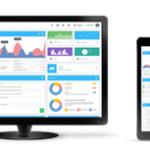 In an age of convergence, where a person accesses the internet is no longer limited. Customers are no longer satisfied with using a computer for purchases, paying bills, banking and doing other forms of ecommerce. This is an era of mobile ecommerce and ecommerce apps for a variety of hand-held devices. Naturally, businesses around the world are looking to make sure that they are mobile ecommerce ready. This article provides insight into some of the mobile ecommerce best practices that business should consider before going the mobile ecommerce route.
In an age of convergence, where a person accesses the internet is no longer limited. Customers are no longer satisfied with using a computer for purchases, paying bills, banking and doing other forms of ecommerce. This is an era of mobile ecommerce and ecommerce apps for a variety of hand-held devices. Naturally, businesses around the world are looking to make sure that they are mobile ecommerce ready. This article provides insight into some of the mobile ecommerce best practices that business should consider before going the mobile ecommerce route.
What is mobile ecommerce?
The capability to do ecommerce transactions using a mobile or other wireless hand-held device is called mobile ecommerce. Mobile ecommerce can be facilitated through a mobile website that is also set up for transactions through a mobile device, or through an ecommerce application that runs on a mobile phone and is designed to facilitate online transactions through mobile devices — or a combination of the two.
Mobile ecommerce best practices
If you are considering mobile ecommerce capability to maximize your business potential, here are some of the best practices you need to keep in mind.
Define the mobile ecommerce goals:
As a business, you would naturally want to make sure that every avenue facilitates a transaction for a potential customer. However, buying on a mobile phone may or may not be the perfect solution for your business. Even if it is, the nature of the ecommerce transaction may be different for the mobile universe. For example, if you have an insurance product, do you need mobile ecommerce to allow customers to buy an insurance plan or do you need it to allow customers to make renewals, purchase add-ons, track policy details, etc? Or, if you have an automobile business, do you need mobile ecommerce to let customers buy cars through their cell phone or should mobile ecommerce capability facilitate making a servicing appointment, buying accessories, providing car maintenance reminders, and other aspects of engagement with the customer? Defining what your customer is more likely to do and appreciate on the mobile phone, and defining your mobile ecommerce goals is the first step to mobile ecommerce adoption.
Mobile App vs Mobile Site
Among the first decisions you need to take is whether you need a mobile website with ecommerce integration or whether you need a ecommerce enabled mobile app. This can be a tougher decision than it seems. Understanding your target customers and their preferences is a key to this decision. Also your business and mobile ecommerce goals can determine whether what you want to achieve is best accomplished through a mobile website or app — or a combination of the two.
Post-transaction capability
It’s not enough to just build mobile ecommerce capability. If customers can do a transaction on the mobile but have to go to a computer for customer support or any other for post-transaction need, then it would result in a bad user experience. You need to define as many post-transaction needs as possible and make sure that the mobile site/app fulfils as many of the needs as possible.
Cross-device Compatibility
Once you have taken the decision on your needs, the process of executing the plans begins. Designing the mobile website/app needs to take into account the fact that almost all devices are unique in many aspects — screen resolutions, browsers, operating systems, device capability and more. It’s important to keep in mind that visitors have lesser patience on a mobile than they do on a website. So the experience needs to be fast and information needs to be intuitive and easy to find.
That’s not all, you also need to make sure that your mobile site/app also have the following best practices that are applicable to any mobile website or app, regardless of whether or not it has ecommerce capability:
- Search box should be easy to find
- Add social media capability
- Cross device capability
- Easy navigation
- Minimal text designed for mobile consumption
- Easy to find and mobile friendly product/service pages
- Simple, fast and mobile friendly check-out process
- Decision on payment gateways and currencies supported
Professional Mobile Ecommerce Design
Building mobile ecommerce capability is not difficult. Taking intelligent decisions about the above considerations to deliver customer delight is the key to mobile ecommerce success. There are no easy solutions to the above — no right or wrong answers. That’s why professional ecommerce web design becomes important. Talk to us about your website ecommerce needs today!
CEO, Flying Cow Design
Attended University of Auckland
Lives in San Francisco Bay Area










